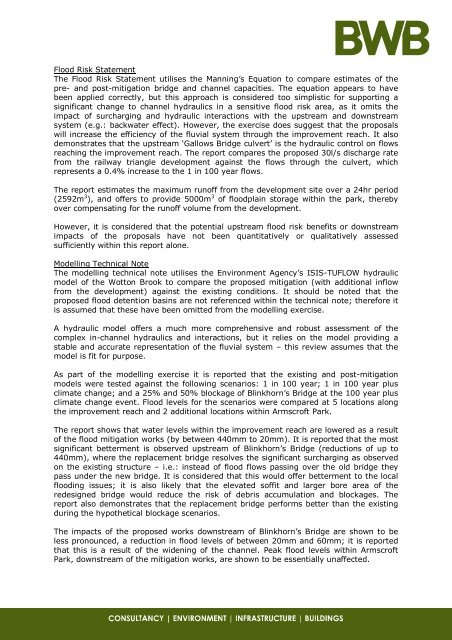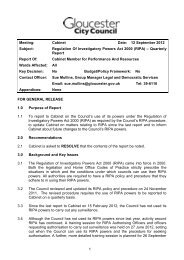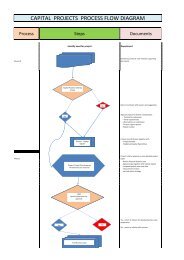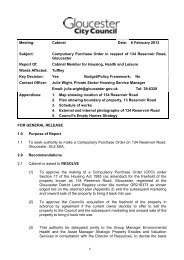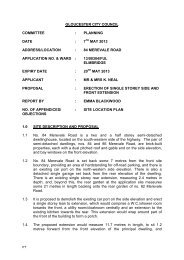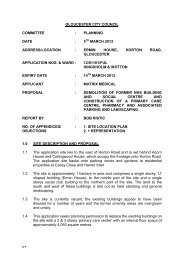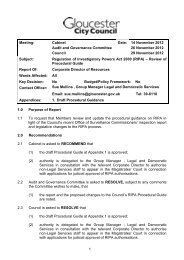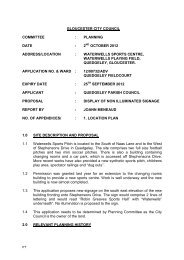12/00218/FUL - Armscroft Park PDF 393 KB - Democracy ...
12/00218/FUL - Armscroft Park PDF 393 KB - Democracy ...
12/00218/FUL - Armscroft Park PDF 393 KB - Democracy ...
You also want an ePaper? Increase the reach of your titles
YUMPU automatically turns print PDFs into web optimized ePapers that Google loves.
Flood Risk Statement<br />
The Flood Risk Statement utilises the Manning’s Equation to compare estimates of the<br />
pre- and post-mitigation bridge and channel capacities. The equation appears to have<br />
been applied correctly, but this approach is considered too simplistic for supporting a<br />
significant change to channel hydraulics in a sensitive flood risk area, as it omits the<br />
impact of surcharging and hydraulic interactions with the upstream and downstream<br />
system (e.g.: backwater effect). However, the exercise does suggest that the proposals<br />
will increase the efficiency of the fluvial system through the improvement reach. It also<br />
demonstrates that the upstream ‘Gallows Bridge culvert’ is the hydraulic control on flows<br />
reaching the improvement reach. The report compares the proposed 30l/s discharge rate<br />
from the railway triangle development against the flows through the culvert, which<br />
represents a 0.4% increase to the 1 in 100 year flows.<br />
The report estimates the maximum runoff from the development site over a 24hr period<br />
(2592m 3 ), and offers to provide 5000m 3 of floodplain storage within the park, thereby<br />
over compensating for the runoff volume from the development.<br />
However, it is considered that the potential upstream flood risk benefits or downstream<br />
impacts of the proposals have not been quantitatively or qualitatively assessed<br />
sufficiently within this report alone.<br />
Modelling Technical Note<br />
The modelling technical note utilises the Environment Agency’s ISIS-TUFLOW hydraulic<br />
model of the Wotton Brook to compare the proposed mitigation (with additional inflow<br />
from the development) against the existing conditions. It should be noted that the<br />
proposed flood detention basins are not referenced within the technical note; therefore it<br />
is assumed that these have been omitted from the modelling exercise.<br />
A hydraulic model offers a much more comprehensive and robust assessment of the<br />
complex in-channel hydraulics and interactions, but it relies on the model providing a<br />
stable and accurate representation of the fluvial system – this review assumes that the<br />
model is fit for purpose.<br />
As part of the modelling exercise it is reported that the existing and post-mitigation<br />
models were tested against the following scenarios: 1 in 100 year; 1 in 100 year plus<br />
climate change; and a 25% and 50% blockage of Blinkhorn’s Bridge at the 100 year plus<br />
climate change event. Flood levels for the scenarios were compared at 5 locations along<br />
the improvement reach and 2 additional locations within <strong>Armscroft</strong> <strong>Park</strong>.<br />
The report shows that water levels within the improvement reach are lowered as a result<br />
of the flood mitigation works (by between 440mm to 20mm). It is reported that the most<br />
significant betterment is observed upstream of Blinkhorn’s Bridge (reductions of up to<br />
440mm), where the replacement bridge resolves the significant surcharging as observed<br />
on the existing structure – i.e.: instead of flood flows passing over the old bridge they<br />
pass under the new bridge. It is considered that this would offer betterment to the local<br />
flooding issues; it is also likely that the elevated soffit and larger bore area of the<br />
redesigned bridge would reduce the risk of debris accumulation and blockages. The<br />
report also demonstrates that the replacement bridge performs better than the existing<br />
during the hypothetical blockage scenarios.<br />
The impacts of the proposed works downstream of Blinkhorn’s Bridge are shown to be<br />
less pronounced, a reduction in flood levels of between 20mm and 60mm; it is reported<br />
that this is a result of the widening of the channel. Peak flood levels within <strong>Armscroft</strong><br />
<strong>Park</strong>, downstream of the mitigation works, are shown to be essentially unaffected.


